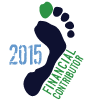Here is the more detailed
Here is the more detailed version of what Mike said....
Every runner, always, will pass over his/her center of gravity over the full course of the footfall. If this were not true, then the runner would fall on his/her face, at least after several steps. (By footfall, I mean the time some part of the foot is touching the ground.)
Because the runner is moving, the exact moment over the center of gravity (CG) is but the tiniest sliver of time (say, 1 millisecond). The runner starts the footfall slightly behind the CG, moves over it, and finishes in front of it (because the runner has moved, but the foot has not).
Over course of the footfall, the foot touches ground for about 200-500ms, depending on the runner. Elite runners are closer to 200ms, possibly even faster. But, exactly half of that time will be behind of the CG and half in front of it (assuming constant speed).
The system must maintain an equalibrium that includes speed, duration of footfall, and lean angle. Without that equilibrium, the runner will fall, since the lean angle has to be balanced by the speed. The foot is the balance point of this system, and that must average out.
Even we barefooters, with our lightning-fast pull and sewing machine cadences, also land in behind of our CG, pass over it, and pull after it.
Landing exactly on the CG would place the entire footfall behind the CG, which would require you to accelerate to come back into equilibrium. Otherwise, the fall angle becomes ever sharper, and eventually you pay your greetings to the asphalt.
All of the above is true of heel landings in shoes as well. The problem with the heel landing is that the heel lands way ahead of the CG, thus making the footfall very long. You could add that their heel landing is braking their speed with every step.*
Forefoot runners generally have shorter footfalls. High cadence runners have shorter footfalls. And running barefoot naturally encourages this. We are just optimizing the physics of the system.
The ideal footfall would last just that tiny millisecond. But, this is not humanly possible. So, we try to get our cadence up and concentrate on a quick pull. But, above all, relax and have fun.
I hope that helps.
Cheers
Paleo
* I noticed this recently in a 10km race as we reached a long, gentle downhill slope. I started passing the other runners like lightning. I had to check my HRM to make sure I wasn't crazy, since it seemed so easy. Then I recalled KenBob's discussion in his recent book. Running barefoot makes it possible to avoid braking the way heel-strikers do. Since it was just a gentle downhill, I didn't need to worry about it getting too fast, so I could just cruise.
I really enjoyed this moment. I have always been small and light, and in the past have raced bicycles. We "mountain flees", of course, crush our competitors on the climbs, but get dusted on the descents, since we lack the weight to pull us downhill (against the air resistance at high speeds proportional to a big guy). Running, air resistance is not high enough to influence the effects of gravity much.




















